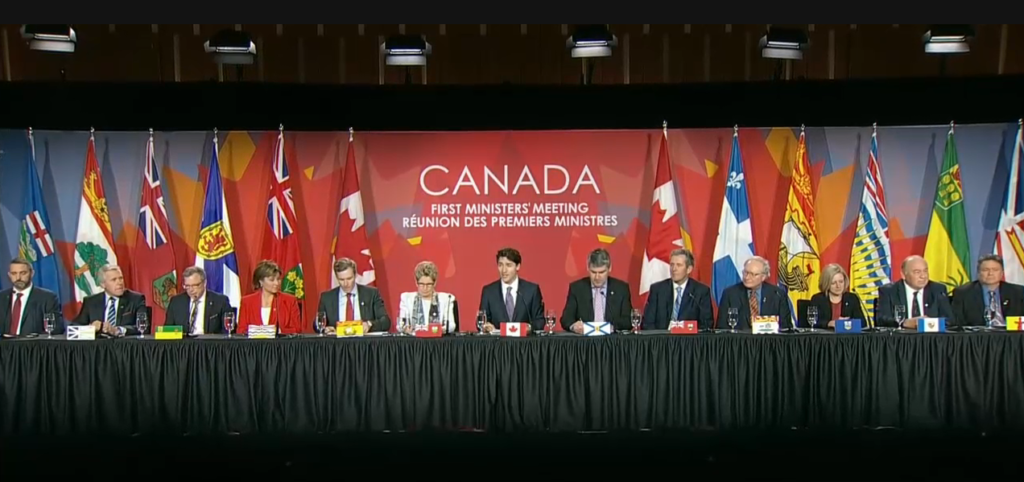
The backdoor in the Pan-Canadian Framework
The Pan-Canadian Framework on Clean Growth and Climate Change (PCF) lets provinces use either carbon taxes or cap-and-trade systems to price carbon. But it also might come with a backdoor that would allow provinces to rely on other, non-pricing climate policies. This blog explains the backdoor, and why it might—or might not—matter, given the realities of climate policy federalism in Canada.
PCF 101
First, a quick review of the PCF. In December 2016, the federal and provincial governments negotiated the Pan-Canadian Framework on Clean Growth and Climate Change (PCF), which lays out priority areas for climate policy-making in Canada, including a national carbon price.
Under the agreement, provinces can either adopt the federal government’s planned carbon pricing system—a carbon tax with output-based pricing for large final emitters (see here for more info)—or they can implement their own. Provinces that go their own way can use either carbon taxes or cap-and-trade, so long as their system aligns with a rising federal floor price (in the case of a tax) or with a declining emissions cap consistent with that price trajectory (in the case of a cap-and-trade).
This instrument flexibility allows provinces like British Columbia, Alberta, Ontario, and Quebec to keep their existing systems, and for other provinces to pursue the approach that makes the most sense for them.
 First Ministers announcing the Pan-Canadian Climate Framework in Vancouver last year
First Ministers announcing the Pan-Canadian Climate Framework in Vancouver last year
The upshot is nation-wide carbon pricing, with design details customized to provincial context. The PCF’s flexibility makes this customization possible. But could it also make it possible for provinces less keen on carbon pricing to rely on other instruments?
It’s an interactions thing
As we discussed in a previous blog, carbon pricing policies can interact with other, non-pricing climate policies when the two overlap. These interactions can matter, especially for cap-and-trade. Here’s a summary Dale wrote in his blog a couple week ago (we believe in recycling here at the Commission):
“The number of permits in a cap-and-trade system defines the levels of allowable emissions (i.e., the cap). An additional policy might reduce emissions in a specific sector. But because the system’s overall cap hasn’t changed, those new reductions will just displace reductions that would have happened somewhere else.
“Think of it like a balloon. The total volume of air (or level of allowed emissions) is fixed. As a result, squeezing one end just leads to a bulge in the other, not a smaller balloon.”
Reducing GHG emissions in a cap-and-trade system can be like whack-a-mole, but less fun
So non-pricing climate policies implemented under cap-and-trade might change the type of GHG mitigation going on (and its costs), but they won’t necessarily change the amount. Interactions under a carbon tax, on the other hand, don’t work this way: Under carbon taxes, any mitigation that a new policy drives will be additional.
Riveting stuff, huh? Just bear with me.
The backdoor
These policy interactions create a potential backdoor in the PCF, where provinces might be able to use non-pricing policies (e.g., regulations, subsidies) to reduce their emissions, instead of carbon pricing.
When a province adopts a cap-and-trade system, it needs to have an emissions cap in line with the requirements of the PCF. But critically, the PCF doesn’t specify how emissions should be kept under the cap.
Normally, if a province’s emissions were going to exceed the cap, reductions would come as a result of permit market dynamics. Firms would buy and trade permits, and the price would rise to a level that reflects their value to emitters. For some emitters, the cost of permits would be worth it, and they would continue to emit (and buy permits). For others, the cost would be too high; instead of buying permits, they would reduce their emissions. Total emissions would end up in line with the cap, and no command-and-control type policies would be needed.
But cap-and-trade provinces are also free to use non-pricing policies to achieve the caps defined by the PCF—in fact, they could use them for all of the necessary GHG mitigation. Where this was the case, the supply of permits would exceed demand. With no permit scarcity, their price could (theoretically at least) fall to zero. The province would still have a PCF-consistent carbon price policy, the price would just happen to be negligible. Other policies would be doing the heavy lifting.
The motive
As we show in our report The Way Forward, carbon pricing is the most effective and cost-effective way to reduce GHG emissions. So why would a province want to use non-pricing policies as a substitute for carbon pricing? (Quick note: we’re focusing here on non-pricing policies as a substitute for carbon pricing; as complements, they can make a lot of sense, as we discuss here)
It might come down to politics. As Marc Jaccard discusses here, the public often isn’t exactly enthusiastic about carbon pricing, especially high and rising carbon prices (i.e., the kind we’ll need). This political constraint on carbon pricing could motivate some provinces to use flexible regulations instead. While these policies would still have a cost (indeed, a slightly higher cost), they would tend to be less visible, and therefore might get less pushback from the public. And since the PCF would allow it, why not?
Does it matter?
So is all this a problem? The answer is yes. And no.
First, it could increase the costs of abatement in Canada. When a province relies mostly on non-pricing policies, the cost to households and businesses will be higher than it would have been under carbon pricing. Meeting Canada’s GHG targets won’t be easy, so it’s important we get there in the most cost-effective way possible. In this sense, the backdoor matters.
But on the other hand, maybe it comes down to pragmatism and the realities of federalism. A province that uses the backdoor is still driving the same amount of GHG mitigation, they’re just making it costlier for themselves. The whole idea of the PCF was to let provinces do climate policy in the way that made the most sense for them. At the end of the day, it’s the provinces’ call. To quote Dale again, “elected governments are best positioned to navigate trade-offs between economic efficiency and political feasibility.”
And while some might argue that provinces using this backdoor undermines the goal of a nation-wide price on carbon, that’s only partly true. Under the backdoor, explicit carbon prices might fall in some places. But as we show in our recent report, non-pricing policies put an implicit price on carbon. Whether explicit or implicit, all provinces would still have a price on carbon. (Granted, implicit prices tend to be opaque, uneven, and, in some cases, higher than necessary. But that doesn’t mean they’re not real.)
It can be hard to see non-pricing policies’ implicit prices, but they’re there (he’s near the middle)
Just because you can doesn’t mean you should
Perhaps the carbon pricing backdoor in the PCF isn’t a flaw. Maybe it’s there as a function of the PCF being designed to provide provinces with flexibility and room to manoeuvre.
But just because the backdoor is there doesn’t mean that provinces should use it. Carbon pricing might not win politicians many popularity contests, but using non-pricing policies as a substitute isn’t a sure bet either: If the public becomes aware of these alternative policies’ high costs, the backlash could be just as strong, if not stronger.
In the view of the Ecofiscal Commission, much better for provincial policy to lean heavily on lower cost carbon pricing, and to leave non-pricing policies in a supporting role. But whether they do so is up to them. To quote Dale a final time:
“Ecofiscal’s job is to point the way to lowest cost policy options and help explain the mechanisms that might matter, and the factors that might increase costs. Even (especially?) if they are weird and complex.”






Comments are closed.